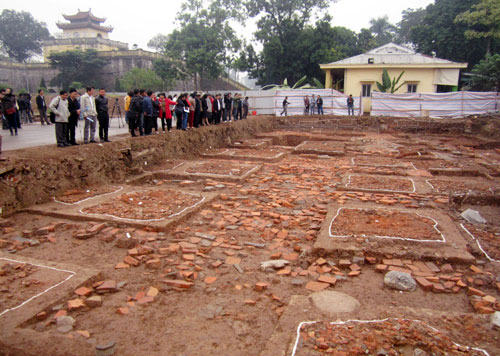Large architecture of the Ly Dynasty revealed in Thang Long Citadel
The first vestiges of the Ly foundation and foundation in the Central axis were discovered for the first time, proving that the ancient palace was elaborately decorated.
On 11/12, Thang Long - Hanoi Heritage Preservation Center reported preliminary results of excavation in 2013. After 4 excavations of 2 holes larger than 100m2, archaeologists found many artifacts and traces. For the first time, the vestiges of the pillars of foundation and the foundation of Ly dynasty were found in the central axis.

The footprint of the Ly dynasty was discovered during the excavation in 2013 at Thang Long Citadel.(Photo: Le Hiep)
14 foundations of gravel piles running in the East-West direction have appeared, of which 12 nails are lined up and posted. The scientists also identified the positions of 4 spaces (5.1-6.3 meters) and 1 facade (2.1 meters) in the East. The other two foundations adjoining the eastern wing of this architecture are said to be of another architecture, not yet clear in scale.
The vestiges of the tiled courtyard are all under the Tran relics. In particular, the ground in the East is quite complete, all are bright red square bricks in size 38 x 38cm.
According to Associate Professor Dr. Trung Trung Tin, Director of the Vietnam Institute of Archeology, these Ly architecture discoveries may be a proof for the ancient palace to be elaborately decorated.
In addition to these findings in the Ly dynasty, scientists also found traces of building a very well-built, solid and large waterway foundation of clay running east-west. In 2012, Ly's first water road was revealed with a stir. Many people believe that the name "waterway" replaced by "sewer" is just a misleading way when archaeologists have not discovered the use of this vestige.
However, Associate Professor Dr. Tong Trung Tin shared that it is necessary to call "waterways" . "It could be a drainage or spiritual waterway. In the sacred areas, there are often streams of water, but people consider stepping through it as a way to remove the ceiling before entering the center like Thien Thien Electric , " said the Director of Vietnam Institute of Archeology.

Large waterways during the Tran Dynasty was one of the important discoveries of the excavation of Thang Long Citadel 2013. (Photo: Le Hiep)
The next important discovery in the excavation in 2013 belonged to the Tran dynasty with 3 architectures: pier foundations were built of broken tiles, traces of wall coverings, flower tub marks. The scientists also found a waterline longer than 16m, 35 - 50cm wide, 1.5m deep running parallel to the waterline of the Ly Dynasty. Construction bricks have several tablets printed in Chinese characters "Vinh Ninh Truong" - the type of Tran dynasty dating.
As for the Le So period, archaeologists found clay to be quite well-covered in all the traces of red mallet bricks. In the time of Le Trung Hung, it was identified the two architectural foundations with large-diameter glass foundations, bundles of foundations and walls. However, these architectural vestiges overlap quite complex, making it difficult to confirm the date.
The vestiges of the Nguyen dynasty were found to be the foundations of the architectures located close to the architecture on the Nguyen Dynasty map (1821-1831). In the excavation pits continue to reveal a rich relic system through Thang Long historical periods. The detailed revision of these relics has further clarified the characteristics of the architectural art decoration in the area of the axis of Thang Long Citadel Center.
The 2013 excavation identified a continuous cultural layer from the Dai La period through the Ly, Tran, Le So and Le Trung Hung periods until the Nguyen Dynasty; The first step is to identify the architectural monuments of the periods of thickening, overlapping, cutting and intermingling, and very rich and complex. The excavation also gradually revealed the main space of Dien Kinh Thien during Le So and Le Trung Hung. However, it is still unclear if the layout of the Ly and Tran dynasties is here.

The excavation in 2013 also discovered many important relics, including the great dragon head of the Tran Dynasty.(Photo: Quynh Trang)
Referring to the heritage conservation direction, Prof. Phan Huy Le, Chairman of the Vietnam Historical Society, said that should not stop at the results of exploration but need to expand the excavation hole to have a comprehensive and complete view more about the ruins."In addition, we should publish the research results to the community so that researchers and the entire population enjoy the relics of his father's ages , " said Prof. Huy Le.
Representatives of the Thang Long Hanoi Heritage Conservation Center said that they would plan to introduce excavation results from 2008 to present to submit to their superiors for permission to display for the people.
- Revealing huge waterways under Thang Long Citadel
- The site of the archaeological site of Hoang Thanh
- Relic area of the Imperial Citadel of Thang Long - Hanoi
- Revealing a complex of ancient architectural foundations in Thang Long Citadel
- China discovered the ancient citadel of the Tang Dynasty built by Cao Bien
- Many new archaeological findings at the Emperor's Citadel
- Admire the world's oldest citadel
- Discovering more relics of the temple in Tran Dynasty in the XIII-XIV century in Tuyen Quang
- China discovered ancient citadel for 2000 years
- The ruins of the ancient city of Puma Punku, Bolivia
- Discovering many vestiges and ancient relics in Ho Citadel
- Discovering ruins of Tran dynasty Buddhist architecture
 Discovered an ancient centipede fossil 99 million years old
Discovered an ancient centipede fossil 99 million years old Discovered bat-like dinosaurs in China
Discovered bat-like dinosaurs in China Discovered a 200-year-old bronze cannon of the coast
Discovered a 200-year-old bronze cannon of the coast Discover 305 million-year-old spider fossils
Discover 305 million-year-old spider fossils